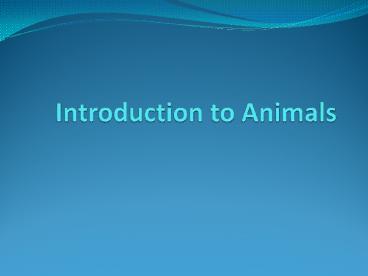Introduction to Animals - PowerPoint PPT Presentation
Title:
Introduction to Animals
Description:
Challenge Earth worms are segmented animals that can live without certain segments, why do you think that is? Phylogenetic Tree Kingdom Animalia contains 35 divions ... – PowerPoint PPT presentation
Number of Views:787
Avg rating:3.0/5.0
Title: Introduction to Animals
1
Introduction to Animals
2
Bell Ringer
- What is the function of the chloroplast?
3
Objectives
- Identify shared characteristics in animals
- Distinguish radial and bilateral symmetry
- Summarize the importance of a body cavity in
animals - Identify how scientists determine evolutionary
relationships between animals
4
Characteristics of Animals
- Heterotrophy
- Mobility
- Multicellularity
- Diploidy
- Sexual reproduction
- Blastula Formation
- Tissue
5
Heterotrophy
- All animals are heterotrophs
- Animals cannot make their own food
6
Mobility
- Animals have the ability to perform rapid,
complex movements - Animals move by using muscle cells
- Swim, walk, crawl, run, fly
7
Multicellularity
- All animals have more than one cell
8
Diploidy
- Diploidy-two copies of each chromosomes
- All animals have two copies of each chromosome.
One copy from mom and one from dad.
9
Sexual Reproduction
- Almost all animals reproduce sexually by
producing gametes. - Sperm cells of all animals have a flagella and
they are highly mobile.
10
Blastula Formation
- Blastula- a hollow ball of cells
- Cells within the blastula eventually develop into
three distinct layers of cells - Ectoderm
- Endoderm
- Mesoderm
11
Blastula
12
- Ectoderm- Outer layer of skin, nervous system,
sense organs - Endoderm- Lining of digestive tract, respiratory,
system, digestive organs, urinary bladder - Mesoderm- Most of the skeleton, muscles,
circulatory system, reproductive organs
13
(No Transcript)
14
Tissues
- The cells of all animals except sponges are
organized into structural and functional units
called tissues - Tissues- groups of cells with a common structure
that work together to perform a certain function
15
Bell Ringer
- What are the three distinct cellular layers that
the Blastula forms into?
16
(No Transcript)
17
Body Symmetry
- All animals have their own Body Plan.
- Different types of Body Plans
- Asymmetry
- Radial Symmetry
- Bilateral Symmetry
18
Asymmetry
- Asymmetry- irregular in shape.
- Asymmetry is the simplest body plan in the animal
Kingdom - Example Sponges
19
Asymmetry
20
Radial Symmetry
- Radial Symmetry- Body parts arranged around a
central axis. - Most animals that exhibit radial symmetry are
aquatic. - Example Starfish or Sea Anemone
21
Radial Symmetry
22
Bilateral Symmetry
- Bilateral Symmetry-A body design in which there
are distinct right and left halves. - In Bilateral Symmetry there are
- Dorsal Surfaces(Top)
- Ventral Surface(Bottom)
- Anterior End(Front)
- Posterior End(Back)
23
Bilateral Symmetry
24
Bell Ringer
- What are the three different types of symmetries?
25
Cephalization
- Most bilaterally symmetrical animals have evolved
an anterior concentration of sensory structures
and nerves. - This is called Cephalization
- Animals with cephalic ends are often active and
mobile.
26
Cephalization
27
Internal Body Cavity
- Bilaterally Symmetrical Animals have three basic
internal body plans - Acoelomates
- Pseudocoelomates
- Coelomates
- Coelom-Body cavity a fluid filled space found
between the body wall and the digestive tract.
28
Acoelomate
- Aceolomate-No Body cavity
29
Pseudocoelomate
- Pseudocoelomate-A body cavity that is located
between the mesoderm and endoderm.
30
Coelomate
- Coelomate-Have a body cavity located entirely
within the mesoderm. - Provides an internal space where mesoderm and
endoderm can be in contact during embryonic
development. - This helped complex organs evolve, why?
31
Coelomate
- Earthworms are coelomates
- True coelom wraps around the digestive tract to
protect organs. - Provides are firm base for animals muscles to
push against.
32
(No Transcript)
33
Body Segmentation
- Segmented animals are composed of repeating
segments.
34
Challenge
- Earth worms are segmented animals that can live
without certain segments, why do you think that
is?
35
Phylogenetic Tree
- Kingdom Animalia contains 35 divions
- Phyla
- Scientists use a Phylogenetic tree to visualize
classification - The animal kingdom can then be divided into
vertebrates and non-vertebrates
36
(No Transcript)
37
(No Transcript)































